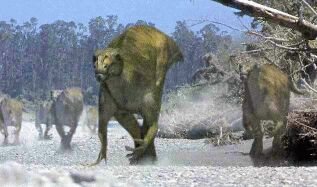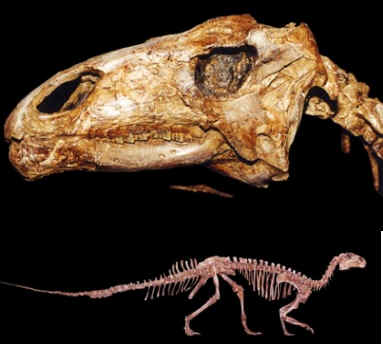
Migrating Muttaburrasaurus herd. from Walking with Dinosaurs © 1999 ABC, BBC
| Ornithischia | ||
| The Vertebrates | Iguanodontia |
| Vertebrates Home | Vertebrate | Vertebrate |
|
Abbreviated Dendrogram
Dinosauromorpha
├─┬─Theropoda
│ └─Sauropodomorpha
│
└─Ornithischia
├─Thyreophora
│ ├─Stegosauria
│ └─Ankylosauria
└─Cerapoda
├─Ornithopoda
│ ╞═Hypsilophodontidae
│ └─Iguanodontia
│ ├─Muttaburrasaurus
│ └─┬─Tenontosauridae
│ │ ├─Tenontosaurus
│ │ └─Rhabdodon
│ └─┬─Dryosauridae
│ └─┬─Iguanodontidae
│ └─Hadrosauridae
└─Marginocephalia
├─Pachycephalosauria
└─Ceratopsia
|
Contents
Overview |
Editor's note: Parts of this page are in need of taxonomic and phylogenetic revision. The unofficial families "Muttaburrasauridae" and "Tenontosauridae" should be discarded, the former being polyphyletic and the latter monotypal (though that wouldn't necessarily invalidate it) On the other hand, Rhabdodontidae is a proper taxan, and should be added for Rhabdodon and co (possibly also including Muttaburrasaurus) (McDonald et al. 2010) MAK120309
Iguanodontia: Iguanodon > Hypsilophodon.
Range: Middle? Jurassic to Late Cretaceous
Phylogeny: Ornithopoda:: Hypsilophodontidae + * : Muttaburrasaurus + (Tenontosauridae + Dryosauridae + (Iguanodontidae + Hadrosauroidea)))
 |
|
Migrating Muttaburrasaurus herd. from Walking with Dinosaurs © 1999 ABC, BBC |
Range: middle Cretaceous of Australia.
Phylogeny: Iguanodontia: (Tenontosauridae + (Dryosauridae + (Iguanodontidae + Hadrosauroidea))) + *.
Comment: It is possible that the large Muttaburrasaurus and the small Atlascopcosaurus and Qantassaurus are related, in which case they could be grouped in an unofficial family "Muttaburrasauridae". Whether this is true or not, there is no doubt that a number of unique hypsilophodontids or basal iguanodontians populated south-east Gondwanaland, at the time right on the south pole. This assemblage features a greater diversity of hypsilophodonts then anywhere else in the world. MAK011118.
Qantassaurus intrepidus Rich and Vickers-Rich, 1999
Horizon: Strzelecki Group of Victoria, Australia
Age: late Aptian
Place: South-East (Polar) Gondwana
Remains: partial lower jaws (two dentaries with teeth)
Length: about 1.8 meters
Comments: Differs from all known hypsilophodonts in having only 12 teeth in the lower jaw, indicating a shorter, deeper face.
Links: Dann's Dinosaur Info: QANTASSAURUS. MAK011118.
Atlascopcosaurus loadsi Rich and Rich, 1989
Horizon: Otway Group of Dinosaur Cove, Victoria, Australia
Age: early Albian
Place: South-East (Polar) Gondwana
Remains: partial upper jaw (Maxilla, teeth)
Length: 2.7 meters
Weight: 125 kg
Comments: Resembles Zephyrosaurus in the structure of its unworn maxillary teeth except for a more pronounced primary ridge Sues & Norman (1990). It is also suggested (ref Thescelosaurus!) that Muttaburrasaurus may be closely related to it, despite the latter's much larger size. Some isolated femora found at the same locality may or may not belong to this species. MAK011118.
Muttaburrasaurus langdoni Bartholomai and Molnar, 1981
Horizon: Mackunda Formation of north-central Queensland; Muttaburrasaurus sp. from other localities
Age: middle Albian
Place: East Gondwana
Remains: Skull and partially complete skeleton, also a fragmentary skeleton
Length: 7 meters
Weight: 1100 kg
Comments: Perhaps Australia's best known dinosaur; certainly it represents one of the most complete skeletons of any dinosaur from this region. Originally included under the Iguanodontidae which it resembles in size and body proportions, and compared to Camptosaurus (similar cranial proportions), it is now thought to be more primitive than either. Muttaburrasaurus was most probably quadrupedal, with a broad low skull bearing a remarkable hollow chamber on the snout, reminiscent of Altirhinus (iguanodont) and Kritosaurus hadrosaurid). This was probably a resonating chamber, although it may also have enhanced the sense of smell (both options are not exclusive, e.g. calls during the mating season, and smell to detect a mate). Unlike all other ornithopods, Muttaburrasaurus had a very powerful, ceratopsian-like shearing, rather than a grinding, dentition. Molnar (1991). This seems to represent an approach to increased chewing efficiency distinct from the iguanodontian one. Although it has been suggested that Muttaburrasaurus may have been partially carnivorous, this seems a misinterpretation of its unique and obviously efficient oral processing mechanism. The original identification of an Iguanodon-style thumb-spike also appears to be in error. A second skull is known, from a slightly earlier form, which appears to represent a more primitive (possibly ancestral?) species.
Links: Dann's Dinosaur Info: MUTTABURRASAURUS (Best on the Web). MAK011118.
References: Molnar 1991); Sues & Norman (1990)
 Tenontosauridae: Rhabdodon, Tenontosaurus
Tenontosauridae: Rhabdodon, Tenontosaurus
Range: middle to Late Cretaceous of North America and Europe.
Phylogeny: Iguanodontia:: Dryosauridae + (Iguanodontidae + Hadrosauroidea)) + * : Tenontosaurus + Rhabdodon.
Note: I have included here the Laurasian members of the family. If Muttaburrasaurus and related forms are tenontosaurs then the two lineages, geographically isolated, followed very different evolutionary paths, although both paralleled the contemporary camptosaurids and iguanodontids, and doubtless fulfilled a similar ecological role. Although the tenontosaurids are similar in overall size, and in skull proportions, to the iguanodontids, the structure and arrangement of the teeth could place them among the Hypsilophodontidae. MAK011118.
Links: DINOSAURS- Family Tenontosauridae an increasingly useful and rapidly improving dino site). ATW030401.
 Tenontosaurus: T. tillettorum Ostrom 1970; T. dossi Winkler et al.. 1997.
Tenontosaurus: T. tillettorum Ostrom 1970; T. dossi Winkler et al.. 1997.
Range: middle Cretaceous of North America
Phylogeny: Tenontosauridae: Rhabdodon + *.
Characters: 1.5 to 7.5+ m; skull long & fairly deep; premaxilla toothless; orbits very large & somewhat rectangular; tail long; manus III with 3 phalanges; prepubic process narrower transversely then deep dorsoventrally
Tenontosaurus tillettorum Ostrom, 1970a
Horizon: Cloverly Formation of Montana, Cedar Mountain Formation of Utah, probably also Antlers Formation of Oklahoma, and Antlers and Paluxy Formations of Texas
Age: Aptian to Middle Albian
Place: Western Laurasia
Remains: over 25 skeletons, plus postcrania and teeth
Length: 6.5 meters
Weight: 500 kg
Comments: distinguished by its unusually long tail (which may or may not have been an aid in swimming), Tenontosaurus has the misfortune to be continually portrayed by dinosaur artists as being torn apart by a pack of hungry Deinonychus. It has been various identified as a hypsilophodont, an iguanodont, and in some separate taxon of its own. As the material spans some ten million years or more, it is not unlikely that several species are included here. MAK011118.
Tenontosaurus dossi Winkler, Murray, and Jacobs, 1997
Horizon: Twin Mountains Formation, Texas; possibly other locations as well
Age: late Albian
Place: Western Laurasia
Remains: at least two skulls and two incomplete skeletons
Length: 7 to 8 meters
Weight: up to 900 kg
Comments: Apparently more primitive than T. tillettorum, it is also larger. MAK011118.
Note: a very large, qudrupedal hypsilophodont?
Image: from Research Casting International
Links: DinoData Dinosaurs T035 TENONTOSAURUS; Tenontosaurus. The Natural History Museum's Dino Directory; Paleontology and Geology Glossary- Te; Dino Land Paleontology News- Nearly Complete Tenontosaurus ...; TENONTOSAURUS; Tenontosaurus Spanish); Tenontosaurus pictures@ Prehistorics Illustrated; Academy of Natural Sciences, Philadelphia. Deinonychus ...; Tenontosaurus tillettorum; Neuigkeiten aus der Wissenschaft German); The Sam Noble Oklahoma Museum of Natural History - NEWS. ATW030401.
Rhabdodon: R. priscus Matheron 1869; R. septimanicus Buffetaut & Le Loeuff 1991.
Range: Late Cretaceous of Europe
Phylogeny: Tenontosauridae: Tenontosaurus + *.
Characters: < 4.5 m; probable beak; coronoid process continuous with alveolar row; alveolar row strongly curved & without lateral shelf; lateral face of dentary smoothly rounded;
Rhabdodon priscus Matheron, 1869 (= Mochlodon Seeley, 1881, Oligosaurus Seeley, 1881, Ornithomerus Seeley, 1881; see also more synonyms at Dino Data entry).
Horizon: various deposits from Austria, France, Romania, and Spain
Age: Campanian and Maastrichtian
Place: Central Laurasia / Western Euramerica
Remains: teeth, isolated postcrania
Length: 4 to 4.5 meters
Weight: around 400 kg
Comments: A fairly common but poorly known late Cretaceous European ornithopod, for a long time considered an iguanodontid, it is now seen as an advanced early, or even proto-, iguanodontian. R. septimanicus Buffetaut and Le Loeuff, 1991 (France) and R. robustus (Nopcsa, 1900) (Maastrichtian of Romania) may or may not be separate species. In any case, given the wide stratigraphic and geographic range, it is likely that more than one species is included here. MAK011118.
Links: DinoData Dinosaurs R013 RHABDODON; RHABDODON; Pereda Suberbiola & Taquet; MUSEE. DINOSAURES - LES COLLECTIONS; dinosaurs. ATW030402.
 Dryosauridae: Ankylopollexia?, Dryosaurus, Kangnasaurus, Valdosaurus?
Dryosauridae: Ankylopollexia?, Dryosaurus, Kangnasaurus, Valdosaurus?
Range: Middle Jurassic to Middle Cretaceous of North America, Africa & Europe, possibly South America.
Phylogeny: Iguanodontia::: Iguanodontidae + Hadrosauroidea) + *.
Links: Biologybase: Checklist of the Non-Avian Dinosaurs; Iguanodontia -- The Dinosauricon; Dryosaurus - Dinosaur - Enchanted Learning Software.
 Iguanodontidae: Iguanodon. Sometimes used to include various transitional forms with varying development of: cris-cross ossified tendons in vertebral column; loss of premaxillary teeth; dental battery formation; fusion of wrist bones; sternal plate shape (kidney-shape to hatchet-shape).
Iguanodontidae: Iguanodon. Sometimes used to include various transitional forms with varying development of: cris-cross ossified tendons in vertebral column; loss of premaxillary teeth; dental battery formation; fusion of wrist bones; sternal plate shape (kidney-shape to hatchet-shape).
Range: Late Jurassic to Late Cretaceous (depending on definition)
Phylogeny: Iguanodontia:::: Hadrosauroidea + *.
long, broad snouts with a horny beak; numerous very small grinding teeth; <3 dentary teeth per tooth position [H98]; maxillary tooth crowns with accessory mesial & distal ridges [H98]; longer neck; second and third fingers were blunt and hoof-like; $? spiked thumb fused to wrist; tibia < femur; opisthocoelous; larger; facultative quadruped; herbivorous.
Links: DinoData: Iguanodontidae; Biologybase: Checklist of the Non-Avian Dinosaurs; Iguanodon Bernissartensis; Iguanodon- Enchanted Learning Software; On the Classification of the Dinosauria (1870); Iguanodon - Suite101.com; see also Camptosaurus links under Ornithopoda.
References: Head (1998) [H98]. 010907.
checked ATW060107
